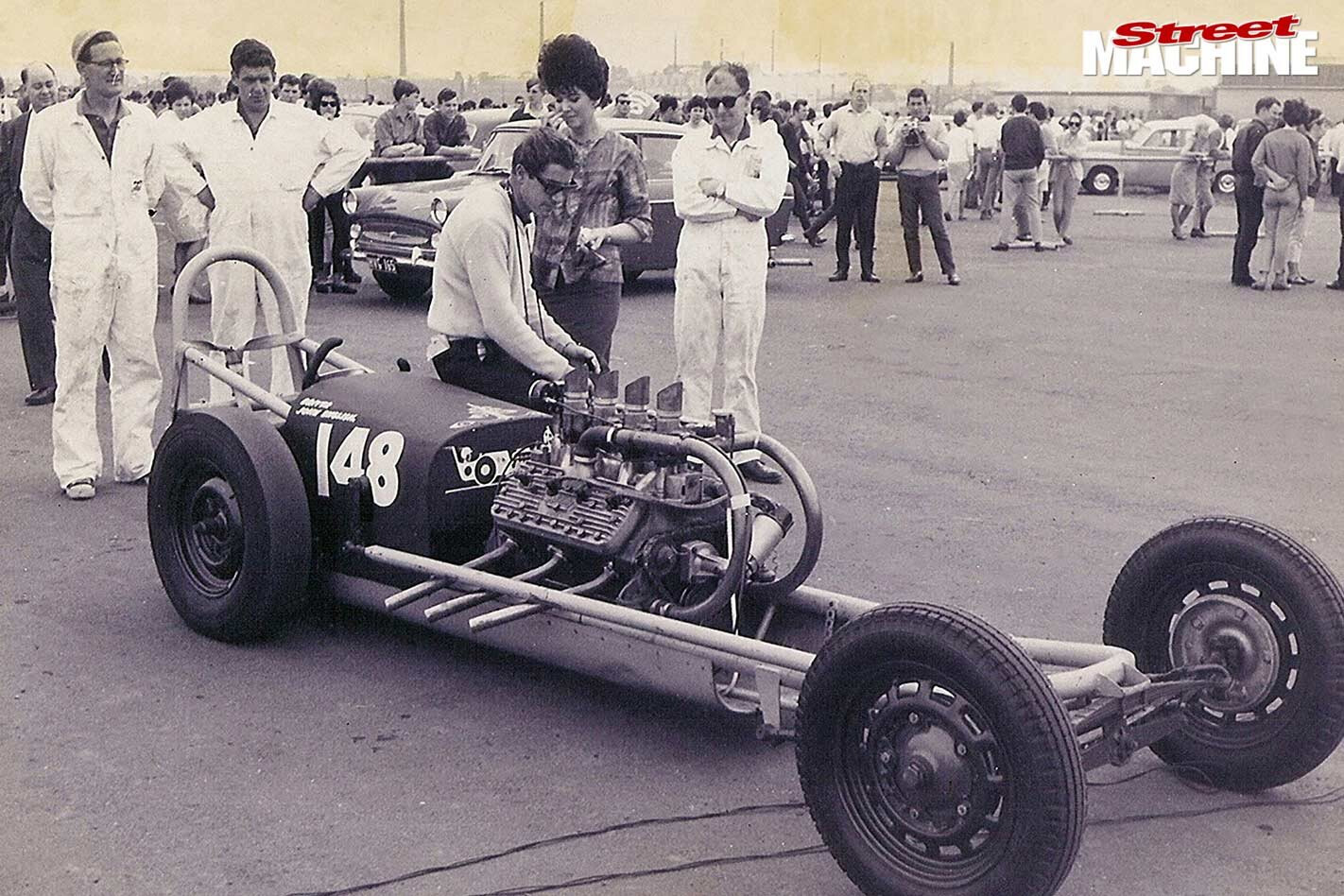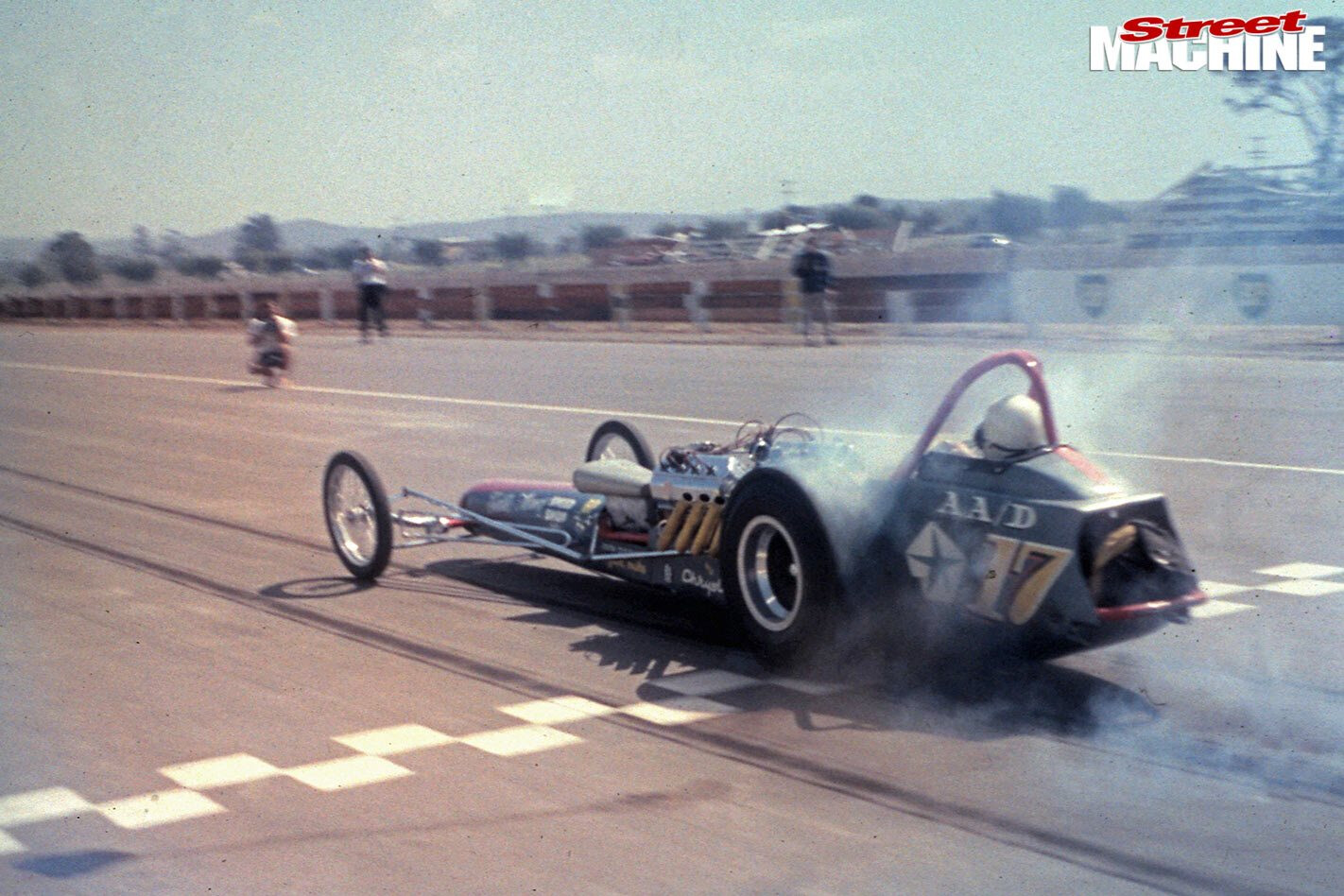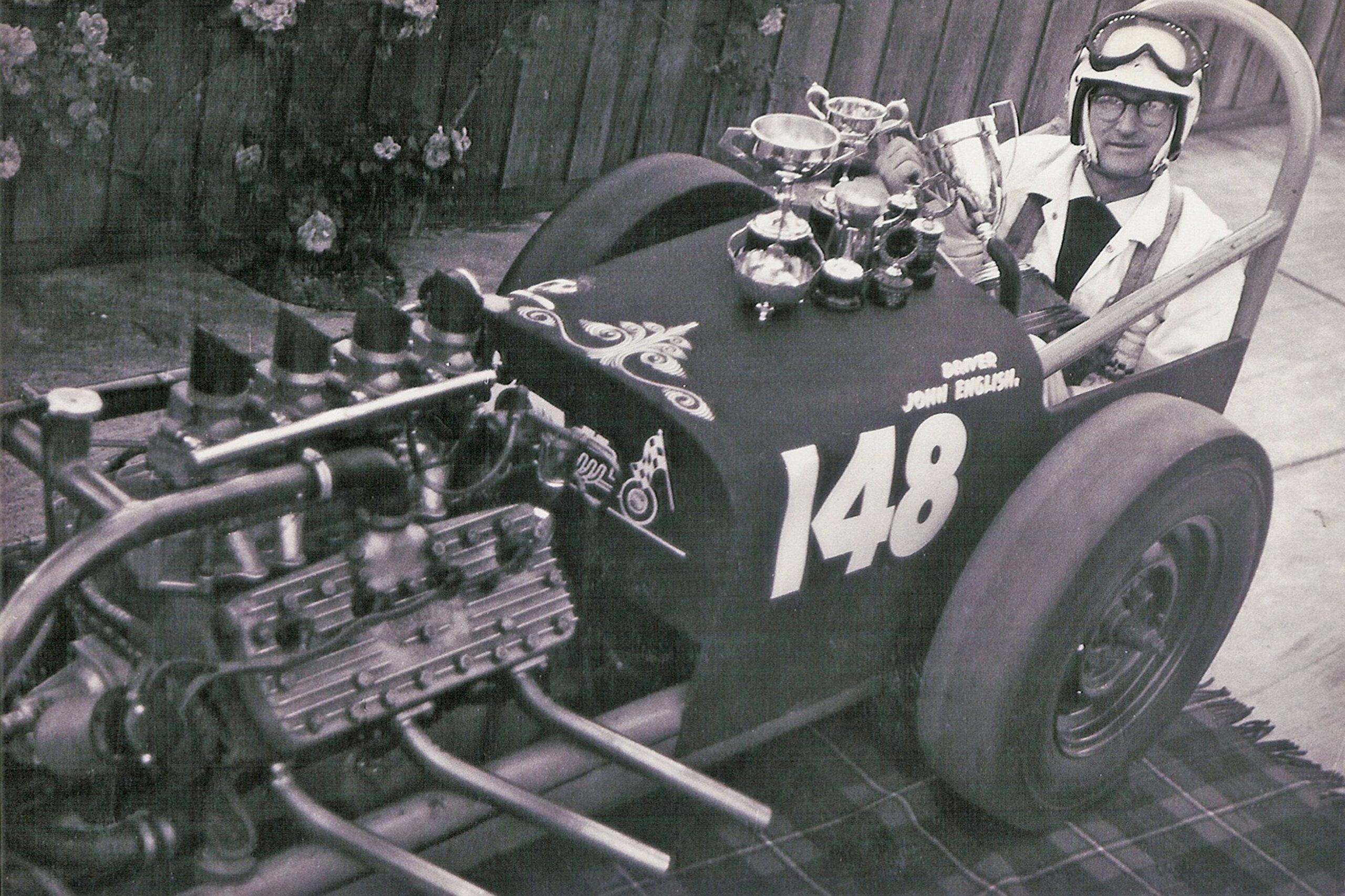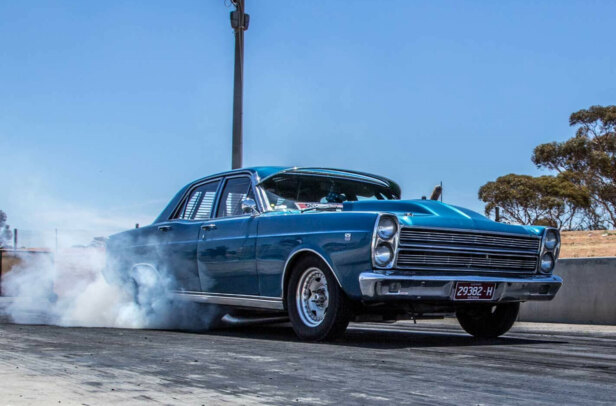WALK through the pits at any drag race event these days and you’ll soon begin to marvel at the technology. The seemingly simple task of getting a vehicle down a straight quarter-mile has evolved well beyond the realms of most home mechanics, leaving newcomers baffled. There was once another time similar to this, when would-be racers were stumped as to their next – or even first – step.
This article on Greg Goddard was first published in Street Machine’s Hot Rod #19 magazine, 2018
The overwhelming majority of Australians would not even have been able to tell you what drag racing was in 1958. Even its few adherents had only the vaguest idea of what it was, and were purely theoretical supporters anyway, as at that stage they had only read about this new motorsport. But they knew they would like it if they saw it, because they called themselves hot rodders, and drag racing was the hot rodder’s motorsport.
The only known photograph of the first dragster built in Australia, in 1958, by Greg Goddard and Brian Morgan. That’s Brian at the wheel, at Pakenham
One of those would-be fans was a young Melbourne enthusiast, Greg Goddard. Today he’s a quietly spoken gentleman approaching his 80th year, living in retirement in Queensland, but once he was a tear-’em-up youngster who just loved cars and all they represented.
“A friend of mine’s father built a speedboat and he used to buy the American Hot Rod magazine,” Greg begins. “My mate and I started reading these and that’s where we got our interest in hot rods and drag racing.”
At the time – 1956 – Greg was in his mid-teens and working as an apprentice mechanic. He had already begun his first hot rod, as had a couple of mates, and they decided they ought to start a hot rod club. So the next week at night school he handed around a note in class stating their intentions and instructing anyone interested to put their name on the note. As it turned out, the teacher saw the note’s passage from one desk to another and seized it.
Greg Goddard in his second dragster with supporters at Pakenham in the late 1950s
After class the teacher gave Greg the piece of paper back, complete with his own name added at the bottom!
The club formed soon after, though that teacher never did become a member. The new club’s name – the Southern Hot Rod Club – was settled on “because there was no other hot rod club south of the border”, according to Greg. Although it might be more accurate to say there was no other south of the equator!
There were as many as 20 guys there on that first night, many of them from the night school.
Greg Goddard in his second dragster at Pakenham in 1959. Its much cleaner lines and more professional finish were a big step up from the first car. Note the concrete launch pads
“I was amazed how much interest there was,” says Greg. “We met in my mate Johnny Mac’s [MacLaggan] father’s garage to start with, and then we moved to a local hall in Malvern that was suitably cheap.”
Greg became the club’s president and remained so for the first four or five years, and his ’34 Ford was a fairly tough affair for its day. He designed and built a fuel injection set-up for the car, which sent it off like a rocket on its first trial, but it quit after about half a mile and the injection idea was scrapped.
Greg Goddard’s second dragster chassis was sold to speed shop owner Eddie Thomas, who loaned it to John English to race in 1963 and ’64, using the sidevalve engine from John’s wrecked rear-engined hillclimb car
The Southern Hot Rod Club initially raced on Dohertys Road in Altona North, but the strip set-up was pretty crude and not particularly safe, so the club went looking elsewhere and in 1958 found a dirt aircraft landing strip on a dairy farm in Pakenham, on the other side of Melbourne. It was quite remote in those days, but it gave the hot rodders a race location off public roads that was flat and relatively safe.
But it was still way short of ideal. The most obvious shortcoming was that the surface was all gravel, and the cars soon began to dig holes at the startline, so with Ampol sponsorship the Pirotta family laid two 30m-long concrete launch pads. But due to that initial gravel surface and the consequent wheelspin, Greg, along with good mate and fellow club member Brian Morgan, built what is today credited as being the first dragster in Australia.
“Greg and I were good mates,” recalls Brian. “We met each other when Greg was 14 and I was 15. We all read American Hot Rod magazine and had seen their pictures of dragsters. Greg said one day: ‘I’m going to build a dragster,’ so away we went.”
Greg takes up the story: “It just seemed that it was the right way to go because of the wheelspin on the gravel track. We set out to build a car – it took us just two weeks – with all the weight on the back end. The driver’s position was set up to be up high at the back so that as the car lifted up at the front it shifted weight over the back and put more weight onto the back wheels. It worked all right.”
Greg Goddard in the foreground with Eddie Thomas working on the dyno, along with the front-blown Chrysler used in Thomas’s dragster
It was built around a pair of ’29 Chevy chassis rails turned upside down, and ran the hotted-up sidevalve engine, radiator and gearbox from Greg’s 34, and a Chev rear axle with semi-elliptical springs. The front end was a beam axle, and the driver’s seat sat on top of the frame right at the back. And braking? “What brakes?” Greg laughs. “When you went over the finish line you’d take your foot off and it would slow down a bit, and eventually you got slow enough to turn around and drive back!”
Eddie Thomas’s purchase of the first firesuit in Australian drag racing made news. Here Thomas shows it off for the media, with Greg Goddard giving the suit a blast with a blowtorch
Both Greg and Brian shared the driving. Today, Greg reckons, you’d fall asleep at the wheel it was so slow, but at the time it seemed very exciting. Greg can no longer recall how quick it went – probably 17 or 18 seconds on the gravel surface – but it was still a lot quicker than the street cars that made up the rest of the competition.
“When we first finished the car we took it out onto the street outside my house in Glen Huntly,” Greg recalls. “I wound it up and dropped the clutch and it got the front wheels up off the ground, turned right and went through the front fence of the people who lived over the road. A bloke who lived down the road saw what had happened and came running up to help me; he was the local copper. He said: ‘Quick, get it out before anybody sees you.’ I was a young motor mechanic who was always doing something around the place, so I guess he decided I wasn’t a bad bloke.”
Outside Eddie Thomas’s speed shop in Caulfield in 1956 (L-R): Thomas, Pat Ratliffe, Greg Goddard and Jim Clarke. Goddard worked for Thomas for several years before moving on to work with Norm Beechey
But the pair didn’t keep the car for long, as they figured it was essentially unsafe. The driving position was exposed, and there was just a single loop of tube over the top, with no surrounding bodywork or other safety tubing.
Unhappy with that first attempt, Greg then set out to build something more in line with the dragsters they’d been seeing in the pages of the American magazines. This time around he did most of the work on his own, with Morgan assisting on some parts.
The wheelbase was determined by the length of Greg’s garage, and during its three months of construction he hid the chassis in his mother’s bedroom – much to her concern – whenever the Southern Hot Rod Club met at his house. “I didn’t want anyone to see it until it was finished,” Greg explains. “Fortunately, my mum had a good sense of humour.”
Greg Goddard at work on the 426 Hemi that Eddie Thomas imported for his dragster in 1966, the first of its kind in the country
The main chassis rail was made from hefty 2.5-inch tubing. The rear end was a narrowed 1940 Ford, and the beam axle front end was from a Ford Anglia, with its original transverse leaf spring. The engine ran ported and polished heads, with a Clay Smith cam and dual Stromberg carbies on a homebuilt crossram manifold, and that worked well too. The power went out through the ’34 Ford gearbox using second and third gears.
Completed in late 1958, that second rail ran at Pakenham until it closed in ’61. Greg found it much better to drive, more responsive and easier to control.
With Pakenham no longer an option, in October ’62 the hot rodders switched their focus to the old Commonwealth Aircraft Corporation airstrip at Fishermans Bend, just 1.5 miles in a straight line from the Melbourne CBD. Through the assistance of the Victorian Police Motor Sports Club, they obtained permission to conduct racing on the asphalt there, which meant Greg could trial his dragster again, this time with a blower. But the standard pistons and rods didn’t agree and quit.
Darryl Harvey, Greg Goddard & Brian Morgan looking dapper at an SHRC ball in the 1950s
By this time, Greg was working as a mechanic at Eddie Thomas’s growing speed shop in Caulfield. Greg worked on a variety of jobs, but after a while he was assigned to Thomas’s dyno. In ’63 Greg built a speedboat and took the sidevalve engine from the dragster to power it, with the rolling chassis left parked at Thomas’s shop. “Eddie rang me and asked if he could buy it from me and I agreed to sell.”
At this time racer John English was keen to run his rear-engined, sidevalve-powered hillclimb car at the Geelong sprints, which were run along Ritchie Boulevard down to the waterfront each year. After he’d already entered, he discovered he couldn’t race because he didn’t have a CAMS licence, so asked Greg to drive.
The damaged John English hillclimb special – which Greg Goddard had put through the hay bales and into trees at the August 1963 Geelong Sprints – gets towed away
“I was part-way along the strip on a run when some kids rolled a box of apples down the embankment next to the course,” Greg remembers. “I stamped on the brakes when I saw this stuff roll out in front of me, and the car, which had huge brakes on the rear and only little brakes on the front, locked up the rear wheels. It swung around, went through the hay bales and between two trees on the left side of the strip. As it went through I saw the left front wheel touch one of the trees, and I was worried that I might have damaged the car. When I looked back the whole engine and transmission was rolling down
the road!”
To keep his racing alive, English borrowed the rolling dragster from Thomas and dropped in the sidevalve engine that had tumbled down the road at Geelong. Soon after, they fitted a blown 318 Chrysler that Thomas had prepared.
Greg Goddard (left), Brian Morgan (third from left) and Johnny MacLaggan (third from right) at a Southern Hot Rod Club gathering at Morgan’s house in the 1950s
After English quit to run his own ’32 roadster gasser, that little dragster, built in a suburban garage by a guy who’d never seen another such vehicle, launched Eddie Thomas into competitive racing, and became the first car in Australia to bust the 140, 150 and 160mph barriers, the first into the 10-second zone, and the first into the nines in July ’65.
In ’68 it was sold to Sydney racer John Taylor, who ran a carbed, then a blown Y-block Ford, and then a blown 331 Chrysler Hemi in it, and it went as quick as 9.7 seconds. It was last reportedly seen in the early 1970s with a Holden six in it, but has long since dropped from sight. At the moment Greg and son Darren are starting work on a rebuilt version of that famous dragster, after some time spent gathering the necessary bits.
In ’63 Greg left Thomas’s shop and went to work for circuit racing legend Norm Beechey. There his dragster-building and racing skills were put to use in the construction of a Holden six-powered rail for Jack ‘Fizzball’ Collins to drive.
“A local engineering company built it, but I told them what we wanted,” Greg says. “The engine was one of Norm’s old S4s. I only had a little bit to do with the running of it before ‘Fizzy’ took over.”
Hot rodder Darryl Harvey prepares to take on RS Abraham’s rear-engined open-wheeler at the 1962 Geelong Sprints. Note the use of ‘hockey stick’ starter switches to activate the timers
Greg then got right away from drag racing. He ran a truck wrecking business for Beechey and ended up buying it from him. In the meantime, from ’63, Greg had become involved in circuit racing, at first with a Holden-powered Formula Libre open-wheeler and later with some very sophisticated rear-engined vehicles.
The chronicle of Greg’s circuit racing is a whole other tale, and it’s likely that there are a bunch more involving his hot rodding days, too. Yep, there’s an awful lot to the Greg Goddard story.
THE DUCK’S GUTS
GRAHAM ‘Blue’ Wilson was a SHRC member in the 1950s and 60s, and his earliest memories of hot rodding date back to 1955 at the St Moritz ice rink at St Kilda, when he was just 16. There, Blue met a bunch of hot rodders who used the ice palace as a hangout, and he got to talking to them. Within a year they’d decided to form a club.
“I remember one night when we were sitting at the rink putting our skates on and Greg Goddard and Brian Morgan, who were very close mates, came in late,” Blue recalls. “They were very excited, and we asked where they’d been. It turned out that that day they’d finished their first triple-carb manifold and fitted it to Brian’s ’38 Ford coupe – with a flathead, naturally – and they’d driven it down to the rink for us to see, but had got tangled up in this street race with this bloke in a late-model sedan.
“At the interval everyone had their skates off and it was down to the street and up with the bonnet. In the light from the front of the building, here’s three polished 97 carbies, fuel lines going out to a little fuel block and little stacks on top of the carbies, all home-made. We thought we were looking at the duck’s guts. It was something really special.”
Bluey also had the first pair of slicks in Australia, made in about 1957 by the Olympic Tyre & Rubber Company for a ’32 sedan he was building. The car had 5in cut out of the roof and 4in out of the body, and was to be powered by a mid-engined, fuel-injected, Ardun-headed sidevalve.
Greg Goddard, Nancy, Brian Morgan in the 1950s
Bluey scrounged up a pair of American casings – “they were a bit more ‘balloon-y’” – and asked the Olympic people if they could do a slick recap. Bluey then asked them to buff them to a slightly dished surface so that at about 20psi they would be flat for maximum surface contact, although the Olympic people cautioned using them at speeds above 100mph.
In the end, Bluey never got to run them as circumstances prevented the completion of his ’32, but Greg Goddard ran them on both of his dragsters, and they were also loaned to Eddie Thomas in 1964 to run 140mph. The slicks were later loaned to Darryl Harvey to run on his Y-block-powered ’34 roadster, and Bluey never bothered to retrieve them. The first slicks in Australia stayed on that car for decades, and were still there when the car was sold recently.
Bluey’s old ’32 sedan body also still exists, and he’s currently fitting it up to a tube chassis he’s looking to build into a 800-1000hp turbo Ford six-powered salt racer.




Comments